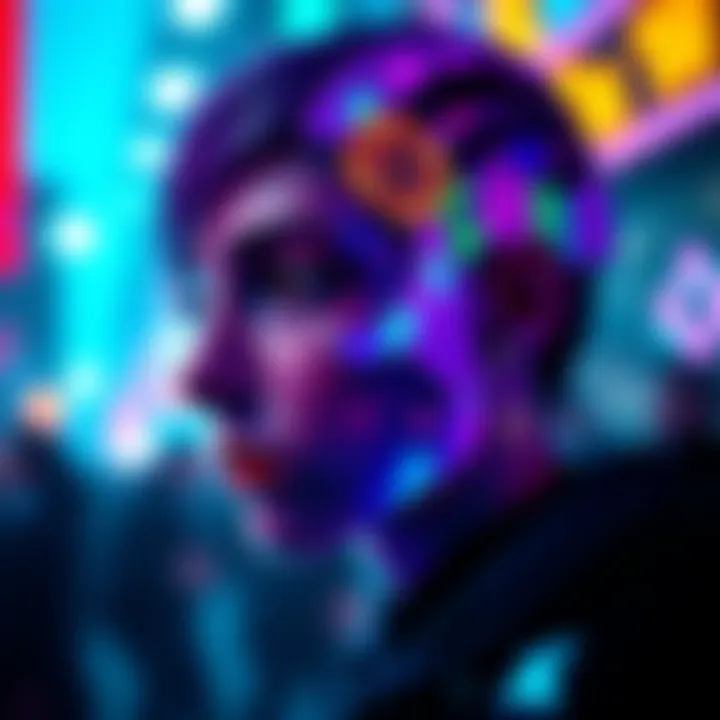The Evolution and Implications of NFT Profile Pictures


Intro
The digital landscape has witnessed a significant metamorphosis in recent years, particularly through the advent of NFT profile pictures, or PFPs as they are often referred to. This trend started as a quirky, novel concept but has quickly burgeoned into a dominant cultural force across various social platforms. With entities and individuals alike jumping into the fray, the implications of these digital art pieces stretch beyond mere aesthetics—inviting discussions on identity, community alignment, and the fluidity of personal branding in our increasingly virtual lives.
In this exploration, we dissect both the technological foundations and societal impacts that underline the NFT PFP phenomenon. By understanding the evolution of NFTs from their mere conceptual phase to the flourishing marketplace they represent today, readers will gain critical insights into the motivations behind their usage and the behavioral shifts they inspire among collectors and communities alike.
Understanding NFTs
In the realm of digital assets, Non-Fungible Tokens, or NFTs, have carved out a distinct niche. Their importance in this article lies not just in their definition but in understanding their transformative potential across various fields. As digital ownership evolves, NFTs represent a shift from traditional to innovative ways of valuing and representing unique items in the virtual world.
Understanding NFTs is essential here as it sets the groundwork for the broader topic of NFT profile pictures. These tokens allow creators and collectors to assert ownership over digital items, making it possible to realize monetary value in the virtual marketplace. This commodification of creativity has significant implications for how we perceive art, music, and even digital real estate. It's a paradigm shift where uniqueness is authenticated on the blockchain, and this is a key pillar of what makes NFTs appealing.
Definition of NFTs
To grasp the concept of NFTs, one must first understand what they are. Essentially, Non-Fungible Tokens are digital assets that signify ownership of unique items or content on a blockchain. Unlike cryptocurrencies such as Bitcoin or Ethereum, which are fungible and can be exchanged one-for-one, NFTs are unique and cannot be directly replaced with something else of equal value. This uniqueness is what gives NFTs their value, making them appealing to buyers and investors alike.
"NFTs are not just art; they are a way to own a piece of digital history on the blockchain."
In terms of digital profile pictures, NFTs allow users to possess something that is verifiably theirs, enhancing their online personas with distinctiveness that a standard image cannot convey. This is where the evolution begins to intersect with identity and community, creating a layered discussion around representation.
The Technology Behind NFTs
Blockchain Fundamentals
At the heart of NFTs lies blockchain technology. This decentralized ledger enables secure ownership and transfer of assets without the need for intermediaries. Each NFT is imbued with metadata that includes essential details about the asset, ensuring that authenticity and ownership are easily verifiable. This property of blockchain creates a level of trust and security that is hard to replicate in traditional forms of ownership.
A notable characteristic of blockchain is its immutability; once data is recorded, it’s nearly impossible to alter. This fact positions blockchain as a robust choice for the creation of NFTs. The unique feature here is how it prevents fraud and duplication in a digital space where copying is as simple as a click of a button. However, it also introduces vulnerabilities, like the environmental concerns surrounding energy consumption in proof-of-work systems.
Smart Contracts
Smart contracts add another layer to the NFT landscape. They are essentially self-executing contracts with the agreement directly written into code, allowing for automated, secure transactions without the overhead of intermediaries. When an NFT transaction occurs, smart contracts automatically enforce the terms of the agreement, ensuring both parties fulfill their obligations.
The inherent benefit of smart contracts is their ability to facilitate transactions efficiently and transparently. They minimize the possibilities of disputes and streamline the trading process. However, they are not without drawbacks; for instance, if a contract is poorly coded, it can lead to significant financial losses or disputes that are difficult to resolve.
Types of NFTs
Though NFTs can encapsulate a wide range of digital assets, a few categories have particularly gained traction in the marketplace.
Art and Collectibles
Art and Collectibles NFTs have been the poster children of this digital revolution. From digital paintings to virtual trading cards, these assets allow artists to monetize their work in ways previously inconceivable. The key feature here is the provenance—it tracks the historical ownership of the artwork, which adds to its value. However, the market can be volatile, with prices wildly fluctuating based on demand and trends.
Music and Entertainment
The music and entertainment sectors are also beginning to see the potential of NFTs. Artists can sell music and concert tickets as NFTs, offering unique experiences to fans. This genre of NFTs allows musicians control over their work, enabling them to receive direct compensation without traditional middlemen. Yet, there’s potential for audience accessibility issues if these assets become prohibitively expensive.
Virtual Real Estate
Finally, there's Virtual Real Estate, a growing sector where parcels of land in digital worlds, such as Decentraland or The Sandbox, are bought and sold as NFTs. The uniqueness of these virtual properties dictates their value, much like real-world real estate. However, a challenge lies in the speculative nature of virtual land, which can lead to significant financial risks.
Through these categories, we begin to see how NFTs are reshaping the landscape of digital ownership, affecting not just collectors and investors, but also creators and audiences alike in the digital space.
The Concept of Profile Pictures in Digital Identity
Digital identity has grown into an essential component of how individuals interact and express themselves in online spaces. Profile pictures, a seemingly simple element of digital identity, play a crucial role in shaping our online persona, serving as visual signifiers that convey information about ourselves and our affiliation to various communities. In the landscape of NFT profile pictures, this importance takes on greater dimensions, enabling users to not only express their identities but also to invest in and showcase unique digital assets. Through the lens of digital representation, we can better understand how cultural, social, and economic factors intertwine in this emerging trend.
Profile Pictures as Digital Signifiers


The Role of Visual Identity
Visual identity is a powerful tool in the digital realm. Profile pictures are much more than mere images; they encapsulate a person’s essence, values, and individuality. When someone chooses a specific image as their profile picture, they are making a statement—whether aligned with their hobbies, affiliations, or aspirations. In the NFT space, this idea takes on even more weight. An NFT profile picture can become a badge of honor, a representation of one’s status within a community or the broader crypto culture.
A common characteristic of visual identity in this context is its ability to foster connections among users. It’s no longer just about presenting oneself but about finding common ground with like-minded individuals. However, the potential downside comes from the risk of superficial judgments based on image alone. People might often equate the worthiness or authenticity of a person with the NFT they choose to display.
Self-Expression in Online Spaces
Self-expression is a fundamental aspect of humanity, and online platforms have become a canvas for this expression. In online spaces, profile pictures can serve as avatars of self-representation, with many choosing unique, often creative interpretations of themselves. NFT profile pictures, in particular, allow users to select images that may reflect their tastes, lifestyles, or even investments in art and culture.
A key trait of self-expression online is its fluidity. Users can change their profile pictures at the drop of a hat, reflecting their current moods or recent shifts in identity—something that traditional static images could never offer. However, this flexibility might breed confusion regarding genuine representation. The immense variety can lead to a fragmented understanding of a user's true identity.
Historical Context
From Static Images to Dynamic Representations
The evolution from static images to dynamic representations unfolds a narrative rich in technological advancement and cultural adaptation. Early digital profiles were often limited to basic, unaltered images, serving as placeholders rather than unique representations. Today, the ability to use NFTs takes this concept to an entirely new level, providing dynamic digital assets that can shift in value and meaning.
What makes this transition noteworthy is its impact on users’ perceptions of identity. Individuals are no longer just passive participants; they actively curate and monetize their digital presence. However, this heightened form of representation brings its own set of challenges—where do we draw the line between a curated identity and one that might be obscured or misleading?
Evolution of Online Avatars
The journey of online avatars has seen immense shifts, from rudimentary graphical representations to intricate designs encapsulating personality and individual expression. First, web-based platforms offered simple avatar options that were often cartoonish and without much customization. Now, with the advent of NFTs, users take control over their digital essence, but this new freedom comes at a price.
A strong characteristic of modern online avatars is their individualization. Users can invest in rare and exclusive NFT profile pictures that reflect their aesthetics and preferences. This creates a form of hierarchy within digital communities where some profile pictures hold significantly more prestige than others. While this provides a fulfilling outlet for expression, it can also lead to issues related to exclusivity and elitism, altering the landscape of community engagement.
Ultimately, as we delve into the factors that define our digital identities, profile pictures remain at the forefront of this complex interaction between technology, culture, and human expression.
NFT Profile Pictures: A New Frontier
NFT profile pictures mark a significant moment in digital culture, blending art, technology, and social identity in unique ways. This new frontier is reshaping how individuals express themselves and connect with communities online. Unlike traditional profile pictures, NFT avatars symbolize ownership and authenticity, thanks to blockchain technology. This evolution goes beyond simple aesthetics, inviting conversations about identity, value, and digital permanence.
The Rise of NFT Profile Pictures
Trends in Digital Collectibles
The surge in popularity of digital collectibles has caught the attention of many, particularly in the realm of NFTs. How people engage with these tokens has transformed typical online interactions. The allure of owning a unique digital asset drives collectors and enthusiasts alike to participate in the NFT marketplace. One key characteristic of trends in digital collectibles is their inherent scarcity. Limited-edition items create a sense of urgency and competition among buyers. This characteristic not only raises demand but also infuses excitement into the digital space.
However, while the scarce nature drives value, it also poses challenges. The volatility of prices can deter newcomers, making it daunting to navigate the marketplace. Still, those who embrace these collectible trends often find joy in the camaraderie and community that emerges among holders.
Influence of Crypto Culture
Crypto culture has significantly impacted the ascent of NFT profile pictures, serving as a catalyst for their adoption. The ethos of decentralization, anonymity, and community-driven movements aligns closely with the nature of NFTs. From online forums to social media, the crypto community passionately discusses digital assets, which, in turn, boosts interest in NFT culture. A notable characteristic here is the collaboration across platforms, where enthusiasts share insights and innovative ideas.
On the flip side, the intensity of this culture can lead to a sense of gatekeeping. New users might feel overwhelmed by the jargon and rapid developments. Still, the foundation laid by this culture fosters creative collaborations and graces the digital identity landscape with an array of imaginative avatars.
Popular Platforms and Projects
CryptoPunks
CryptoPunks stand as trailblazers in the NFT space, setting the stage for countless projects that followed. Created in 2017, these 10,000 unique 24x24 pixel art characters are among the first NFTs to hit the market, establishing a benchmark for digitized collectibles. Their immense cultural significance and rarity make them a fascinating case study in the evolution of NFT profile pictures. Collectors find value not just in owning a punk but in being part of a historic digital art movement.
Of course, this uniqueness does not come without downsides. As prices soar into the hundreds of thousands, access to these icons can be out of reach for many, creating a divide within the community.
Bored Ape Yacht Club
Bored Ape Yacht Club represents another noteworthy collection that has captured the zeitgeist. Launching in April 2021, this project features 10,000 unique hand-drawn apes, each with its own traits and style. The exclusive membership model offers owners benefits like access to virtual events and other perks, making it more than just a profile picture. The community element is strong, as owners often gather at events and online discussions, enhancing their experience beyond mere ownership.
Yet, as appealing as this may be, the pressure of maintaining status within the community can weigh heavily on some owners. It raises questions about whether ownership equates to a social status, influencing how individuals perceive their digital identity.
Other Noteworthy Collections
Beyond CryptoPunks and Bored Ape Yacht Club, other collections like World of Women and Cool Cats are forging their paths. Each project resonates with distinct communities and aesthetics, showcasing the diversity in the NFT profile picture market. A major characteristic of these collections is their focus on inclusivity. By engaging various artists and styles, these projects contribute to the broad tapestry of identity expression in digital spaces.
However, the rapid influx of new collections can lead to market saturation, where unique value becomes harder to discern among countless options. This scenario may frustrate collectors and enthusiasts looking for distinct identities.


Aesthetic and Community Significance
Visual Style and Demographics
The aesthetic appeal of NFT profile pictures plays a pivotal role in their adoption and community engagement. The designs often reflect not only the preferences of collectors but also broader cultural trends and influences. Color schemes, character traits, and themes vary widely, appealing to a broad demographic range. One distinct advantage of this diversity is the empathy and connection it fosters among users who identify with similar visuals.
Nevertheless, the focus on aesthetic value sometimes overshadows deeper meanings or stories behind the art, potentially leading to superficial engagements within communities.
Community Engagement and Branding
Community engagement stemming from NFT profile pictures is powerful. Many projects encourage owners to participate actively, whether through virtual meetups, social media interactions, or collaborative art initiatives. This sense of belonging significantly strengthens brand loyalty and helps cultivate a supportive atmosphere.
The unique aspect of this engagement is that it allows users to blend personal branding with community building. Such interactions can elevate an individual’s digital footprint in ways traditional profiles did not facilitate. Still, this blending may also create tensions for those who feel pressured to uphold brand personas that may not reflect their true identities.
The emergence of NFT profile pictures is more than a trend—it represents a transformation in how we perceive and express identity in an increasingly digital world.
Implications for Identity and Community
The concept of digital identity has undergone a fundamental shift with the rise of NFT profile pictures. These unique digital assets, embedded with ownership rights within the blockchain, provide a new avenue for self-representation in the online landscape. They influence not only how individuals perceive themselves but also how they interact with others within digital communities. As we unpack the implications for identity and community, it becomes evident that NFT profile pictures play a crucial role in shaping social dynamics and economic behaviors in the digital realm.
Cultural Impact of NFT Profile Pictures
Reinforcing Group Identity
NFT profile pictures have the uncanny ability to strengthen group identity among users. It’s not just about picking any old image; these digital tokens often signify membership in a collective, whether that be a community of crypto enthusiasts or fans of a specific movement. For example, the rise of the Bored Ape Yacht Club has turned these images into badges of honor, showcasing not just ownership but also affiliation with a particular community. This creates an invisible thread binding members together, enhancing solidarity and shared experience.
- Key Characteristic: The unique artpieces often hold deeper meanings, resonating with those who share similar ideals or aesthetics. This goes beyond mere representation; it’s a form of active participation in a narrative.
- Advantages: By solidifying group identity, NFT profile pictures can foster a sense of belonging and emotional investment in a community.
- Disadvantages: However, this can also lead to exclusivity, discouraging newcomers who cannot tap into these expensive collections.
Diversifying Digital Narratives
On the flip side, NFT profile pictures open the door for a plethora of digital narratives. They enable users from varied backgrounds to express their unique stories through distinct visual languages. This is a significant step away from more traditional representations, which often favor a homogeneous look. By allowing diverse artistic styles to thrive, these NFTs can champion inclusivity and empower voices that have historically been marginalized in mainstream platforms.
- Key Characteristic: The diverse array of designs reflects individuality and cultural heritage, allowing narratives that were once constrained by societal norms to flourish.
- Advantages: Diversity cultivates richer online dialogues, facilitating discussions that might have been overlooked previously.
- Disadvantages: Yet, with so many narratives battling for attention, there can also be a dilution of individual voices as larger, louder communities overshadow others.
Economic Considerations
Monetization of Digital Identity
The emergence of NFT profile pictures has ushered in a wave of monetization opportunities. Users find themselves in a unique position where their digital identity can translate to real-world value. As creators sell their NFTs for hundreds or even thousands of dollars, the line between personal brand and business becomes increasingly blurred. This highlights a symbiotic relationship where identity and economic prospects intertwine.
- Key Characteristic: The ability to monetize one's digital representation allows for creative freedom and financial success that wasn’t previously available.
- Advantages: It empowers individuals to capitalize on their personal brand, fostering an environment where creativity is not just appreciated but also rewarded.
- Disadvantages: However, this can lead to commodification of identity, where self-worth becomes increasingly tied to financial capital rather than intrinsic qualities.
Effects on Status and Value
Similarly, NFT profile pictures carry implications for status and perceived value within digital spaces. Holding a rare or sought-after profile picture can elevate someone's status within a community, often equating ownership with personal success. Collecting these digital assets is not just about artistry; it's also a power play that shapes social hierarchies.
- Key Characteristic: The rarity and exclusivity of certain NFTs can generate demand, thereby increasing their market value.
- Advantages: This creates a vibrant marketplace that rewards savvy investors and enhances community engagement.
- Disadvantages: However, it can also instigate envy and competition, ultimately leading to a fragmented community where worth is measured solely by ownership rather than contribution.
The interplay of identity, community, and economy within the NFT space reveals profound shifts in our understanding of digital representation. As we move deeper into this territory, the implications stretch far beyond simple profile pictures; they carve out a new arena where identity, culture, and finances collide.
Privacy, Ownership, and Ethics
In the world of NFTs, the discussions around privacy, ownership, and ethics don't just brush the surface; they dig deep into the very foundation of what our digital interactions embody today. As more people stake their claims to digital identity through non-fungible tokens, the structural integrity of these claims is under scrutiny. Understanding the implications of these pillars can reveal the benefits and concerns faced by users and creators alike. As stakeholders in this evolving narrative, grappling with these concepts not only shapes the engagement with NFT profile pictures, but also redefines the ethos of digital interaction.
Ownership Rights in the Digital Realm
Legal Frameworks Surrounding NFTs


Legal frameworks around NFTs form the bedrock upon which ownership claims are built. Governments and institutions are working to catch up with blockchain technology, which often operates in a decentralized manner lacking a traditional regulatory structure. Copyright law serves as the most relevant vehicle through which ownership is often articulated. Thus, the centralized models of intellectual property can be both useful and limiting in scope.
One key characteristic of these frameworks is their relative ambiguity; jurisdictions vary widely on how they apply established laws to digital assets. This uneven terrain presents unique advantages, like enhanced innovation and flexibility in ownership rights but also poses risks. Creators may find themselves bewildered by what protections are available or if they even exist at all, often leading to heated debates about who truly owns what in this expansive digital space.
Another aspect is the question of transferability. NFT ownership is not always a straightforward transaction. The challenge lies in ensuring that buyers understand what rights they are acquiring and what limitations may exist concerning the usage of the underlying asset. Understanding legal frameworks and their ramifications in NFTs is pivotal for creating a solid foundation. This knowledge not only protects creators but empowers collectors to engage confidently in this marketplace.
Intellectual Property Issues
Addressing intellectual property issues is necessary for anyone dipping their toes into NFT waters. The question of what can be owned in the NFT space is complex. For instance, purchasing an NFT doesn’t automatically grant the owner full rights to the image or art it represents.
A key characteristic here revolves around licensing agreements. These contracts can dictate the extent of rights transferred to the buyer versus the creator, often leading to misunderstandings. As a beneficial aspect for this article, it is important to highlight how licensing can provide clarity and protect both creators and collectors in this wild landscape of digital ownership.
However, the downside surfaces when these intellectual property nuances lead to confusion or disputes as ownership and usage rights are debated. Thus, it’s essential for both creators and buyers to be aware of these nuances, ensuring informed decisions. This awareness holds the potential to enhance trust and understanding within the NFT community, which can ultimately lead to more sustainable growth in the ecosystem.
Concerns Regarding Privacy
Data Usage and Surveillance
As NFTs become commonplace in digital identity, concerns about data usage and surveillance are becoming more pronounced. Every click and interaction leaves a trail, and it’s important to understand who is watching and how data is being utilized. The NFT space, characterized by its blockchain technology, allows for greater visibility of transactions and ownership, adding layers of complexity.
A key characteristic of this data landscape is its permanence; transactions are recorded on the blockchain, making them available for analysis long after they occur. While this provides transparency and security to users, it also means that privacy may be compromised. The potential for surveillance by third-party entities or even peers raises questions around the balance between sharing and safeguarding one’s data.
The unique feature of this aspect lies in the power dynamics—those who control data can dictate terms and shape narratives. As users engage with their NFT profiles, the implications of their data trails may impact their roles within online communities. The fine balance between embracing the benefits and guarding against potential overreach remains an ongoing discussion in this digital era.
Anonymity Versus Authenticity
In the ongoing push for identity through NFT profile pictures, the balance between anonymity and authenticity emerges as a key theme. Anonymity offers users a sanctuary—a canvas where they can express themselves without the ever-watchful eyes of the digital world. This approach fosters inclusivity and a richer diversity in expression, inviting participation from various segments of society that may feel put off by conventional norms.
However, this same cloak of anonymity can lead to issues of accountability. It can provide a loophole for bad actors, creating issues that counteract the community's trust and safety. Anonymity carries the potential to breed harmful behaviors, which can undermine the very essence of the positive interactions NFTs aim to enhance. On the other hand, embracing authenticity through verified identities encourages responsible behaviors and creates a sense of connectedness.
Thus, navigating this tightrope walk between the two equally valid stances complicates the overall picture of digital identity. Addressing these concerns allows for a richer conversation around how NFT profile pictures are not merely artistic expressions but also powerful statements about how we wish to portray ourselves in this vast digital expanse.
Future Outlook on NFT Profile Pictures
As the landscape of digital identity continues to metamorphose, NFT profile pictures represent a burgeoning frontier in how individuals express themselves online. Navigating this evolution unlocks various possibilities for further integration of rich visual identity in virtual realms. Observing the trends today reveals just how significant these changes could become in shaping future societal norms surrounding identity, community, and personal branding.
Emerging Trends
Integration with Virtual Reality
The melding of NFT profile pictures with virtual reality (VR) offers an intriguing glimpse into a more immersive digital future. With VR rapidly gaining traction, the ability to showcase unique NFT avatars in expansive virtual spaces becomes essential. This integration doesn't just offer a novel aesthetic; it transforms how users interact with each other, making connections more engaging. Avatars that reflect personal style or adherence to certain subcultures enhance the online social experience, allowing for deeper emotional connections.
One key characteristic of this integration is the immersive nature of VR. In a virtual landscape where users can pop in and out of various worlds at will, the use of NFT profile pictures lets individuals maintain a certain level of individuality, even when moving between different platforms. The primary advantage here is that it shifts digital interactions from mere text-based conversations to vivid, personalized exchanges. However, potential downsides exist—such as the increasing need for sophisticated hardware, making this experience accessible primarily to tech-savvy users only.
"The fascinating aspect of VR integration is the opportunity it presents for visual storytelling, leading to more authentic interactions."
Potential Expansion into Other Media
Another promising trend involves the potential expansion of NFT profile pictures into other media forms, such as gaming, marketing, and even mainstream media. Here, the NFT serves not just as profile visuals but as integral components of larger narratives within various platforms. While some may view this as merely an expansion of digital real estate, the reality is more nuanced. This cross-media potential allows creators to leverage their profile pictures as dynamic assets that migrate from one context to another.
A standout feature of this expansion is the ability for users to bring their visual identity into diverse environments, from intricate games to promotional material for brands. This reinforces their ownership rights and encourages a more interconnected digital ecosystem. Yet, with these advantages comes the challenge of maintaining authenticity; when an NFT is used across multiple channels, it can become diluted, losing some of its original resonance. Thus balancing uniqueness against widespread adoption becomes a pivotal concern.
Societal Shifts
Impact on Digital Interaction
The impact of NFT profile pictures on digital interaction cannot be overstated. In an age when experiential engagement is more sought after than simple transactions, these assets foster a sense of belonging and identity. NFT profile pictures encourage users to connect over shared visual aesthetics and cultural symbols, leading to more enriched interactions.
The key characteristic here is the augmenting effect these profile pictures have on establishing community ties. Aspects of shared culture and mutual interests become visually represented, thus elevating communication from abstract to tangible. An advantage of this enriched interaction is that individuals may feel more invested in their communities, enhancing engagement levels. Yet, on the downside, it may inadvertently contribute to exclusionary practices, where those without access to NFTs feel marginalized in digital spaces.
Redefining Personal Branding
NFT profile pictures serve as a powerful tool for redefining personal branding. With a vast digital realm available to today's user, creating a unique identity that stands out is essential. These profile pictures encapsulate one's personality, artistic preferences, and even values, shaping how they are perceived within online communities.
The defining trait of this personalization is the enhanced autonomy it provides. Individuals no longer just represent themselves with generic images; instead, they curate their identities through calculated visual choices. The unique feature here is the democratization of branding; users from varied backgrounds can tell their personal stories in myriad ways. However, this newfound autonomy may also lead to difficulties in maintaining authentic engagement, as individuals might grapple with pressure to continually project an idealized version of themselves.







